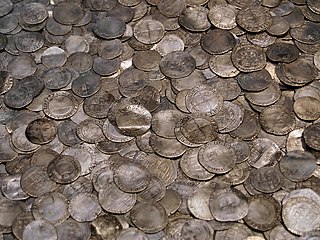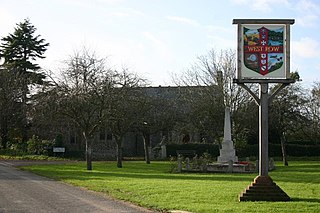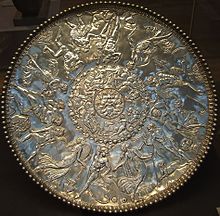
A hoard or "wealth deposit" is an archaeological term for a collection of valuable objects or artifacts, sometimes purposely buried in the ground, in which case it is sometimes also known as a cache. This would usually be with the intention of later recovery by the hoarder; hoarders sometimes died or were unable to return for other reasons before retrieving the hoard, and these surviving hoards might then be uncovered much later by metal detector hobbyists, members of the public, and archaeologists.

Traprain Law is a hill 6 km (4 mi) east of Haddington, East Lothian, Scotland. It is the site of a hill fort or possibly oppidum, which covered at its maximum extent about 16 ha. It is the site of the Traprain Law Treasure, the largest Roman silver hoard from anywhere outside the Roman Empire which included exquisite silver artefacts.

Niello is a black mixture, usually of sulphur, copper, silver, and lead, used as an inlay on engraved or etched metal, especially silver. It is added as a powder or paste, then fired until it melts or at least softens, and flows or is pushed into the engraved lines in the metal. It hardens and blackens when cool, and the niello on the flat surface is polished off to show the filled lines in black, contrasting with the polished metal around it. It may also be used with other metalworking techniques to cover larger areas, as seen in the sky in the diptych illustrated here. The metal where niello is to be placed is often roughened to provide a key. In many cases, especially in objects that have been buried underground, where the niello is now lost, the roughened surface indicates that it was once there.

Ding ware, Ting ware or Dingyao are Chinese ceramics, mostly porcelain, that were produced in the prefecture of Dingzhou in Hebei in northern China. The main kilns were at Jiancicun or Jianci in Quyang County. They were produced between the Tang and Yuan dynasties of imperial China, though their finest period was in the 11th century, under the Northern Song. The kilns "were in almost constant operation from the early eighth until the mid-fourteenth century."

The Hoxne Hoard is the largest hoard of late Roman silver and gold discovered in Britain, and the largest collection of gold and silver coins of the fourth and fifth centuries found anywhere within the former Roman Empire. It was found by Eric Lawes, a metal detectorist in the village of Hoxne in Suffolk, England in 1992. The hoard consists of 14,865 Roman gold, silver, and bronze coins and approximately 200 items of silver tableware and gold jewellery. The objects are now in the British Museum in London, where the most important pieces and a selection of the rest are on permanent display. In 1993, the Treasure Valuation Committee valued the hoard at £1.75 million.

The Water Newton Treasure is a hoard of fourth-century Roman silver, discovered near the location of the Roman town of Durobrivae at Water Newton in the English county of Cambridgeshire in 1975. The hoard consisted of 27 silver items and one small gold plaque. Because of inscriptions found on some of the pieces in the collection it has been suggested that they may have been used in a local church, and they therefore comprise the earliest probable group of Christian liturgical silver yet found in the Roman Empire.

The Thetford Hoard is a hoard of Romano-British metalwork found by Arthur and Greta Brooks at Gallows Hill, near Thetford in Norfolk, England, in November 1979, and now in the British Museum. Dating from the mid- to late-4th century AD, this hoard is a collection of thirty-three silver spoons and three silver strainers, twenty-two gold finger rings, four gold bracelets, four necklace pendants, five gold chain necklaces and two pairs of necklace-clasps, a gold amulet designed as a pendant, an unmounted engraved gem, four beads, and a gold belt-buckle decorated with a dancing satyr. A small cylindrical lidded box made from shale also belonged to the hoard.

The Ormside Bowl is an Anglo-Saxon double-bowl in gilded silver and bronze, with glass, perhaps Northumbrian, dating from the mid-8th century which was found in 1823, possibly buried next to a Viking warrior in Great Ormside, Cumbria, though the circumstances of the find were not well recorded. If so, the bowl was probably looted from York by the warrior before being buried with him on his death. The bowl is one of the finest pieces of Anglo-Saxon silverwork found in England.

West Row is a small village and civil parish in the English county of Suffolk. It is generally considered the edge of The Fens.

The Vinkovci Treasure or Cibalae Treasure is a hoard of late Roman silver plate, discovered in Vinkovci, Croatia at the end of March 2012. Consisting of 48 artifacts weighing a total of about 36 kilograms (79 lb), the hoard includes a variety of domestic utensils and tableware, some of which is elaborately decorated with various designs and depictions. The hoard appears to have been made locally, probably in a workshop in the town, and is thought to date to the late 4th century AD. Following its discovery during construction works in the centre of Vinkovci, it was put on public display in Vinkovci and at the Museum of Arts and Crafts in Zagreb prior to a programme of conservation funded by the Croatian government.

The Esquiline Treasure is an ancient Roman silver treasure that was found in 1793 on the Esquiline Hill in Rome. The hoard is considered an important example of late antique silver work from the 4th century AD, probably about 380 for the major pieces. Since 1866, 57 objects, representing the great majority of the treasure, have been in the British Museum.

The Chaourse Treasure is a hoard of Roman silver found in Chaourse, a village near Montcornet, Aisne in northern France in 1883. Dating between the 2nd and 3rd centuries AD, the treasure is one of the most complete table services to survive from antiquity. This important hoard is now part of the British Museum's collection.

The Caubiac Treasure is a Roman silver hoard found in the village of Thil, southern France in 1785 that is now kept in the British Museum in London.

The Chatuzange Treasure is the name of an important Roman silver hoard found in the village of Chatuzange-le-Goubet in the department of Drôme, south-eastern France. Since 1893 it has been part of the British Museum's collection.

The Carthage Treasure is a Roman silver hoard, which was found in Tunis, Tunisia, at the site of the ancient city of Carthage. The treasure principally consists of silver tableware and jewellery, most of which is now held at the British Museum.

The Canterbury Treasure is an important late Roman silver hoard found in the city of Canterbury, Kent, south-east England, ancient Durovernum Cantiacorum, in 1962, and now in the Roman Museum, Canterbury, Kent. Copies of the main items are also kept in the British Museum.

The Bursa Treasure or Brusa Treasure is the name of an early Roman silver hoard found in the city of Bursa, Turkey. Since 1913, the entire treasure has been at the British Museum.

The Boscoreale Treasure is a large collection of exquisite silver and gold Roman objects discovered in the ruins of the ancient Villa della Pisanella at Boscoreale, near Pompeii, southern Italy. Consisting of over a hundred pieces of silverware, as well as gold coins and jewellery, it is now mostly kept at the Louvre Museum in Paris, although parts of the treasure can also be found at the British Museum.
The Traprain Law treasure is a hoard of late Roman hacksilver, found on the hillfort of Traprain Law during excavations in 1919. It is the largest hoard of Roman hacksilver currently known, weighing just over 23 kg. It consists mostly of Roman silver vessels, a few of which are complete but most of which had been cut into fragments or crushed. There are a few items of personal equipment and coins. The hoard was probably buried in the early fifth century AD. Early interpretations saw it as loot; more recent views prefer to see it as diplomatic gifts or payment for military service. It is currently on display in the National Museum of Scotland in Edinburgh.























